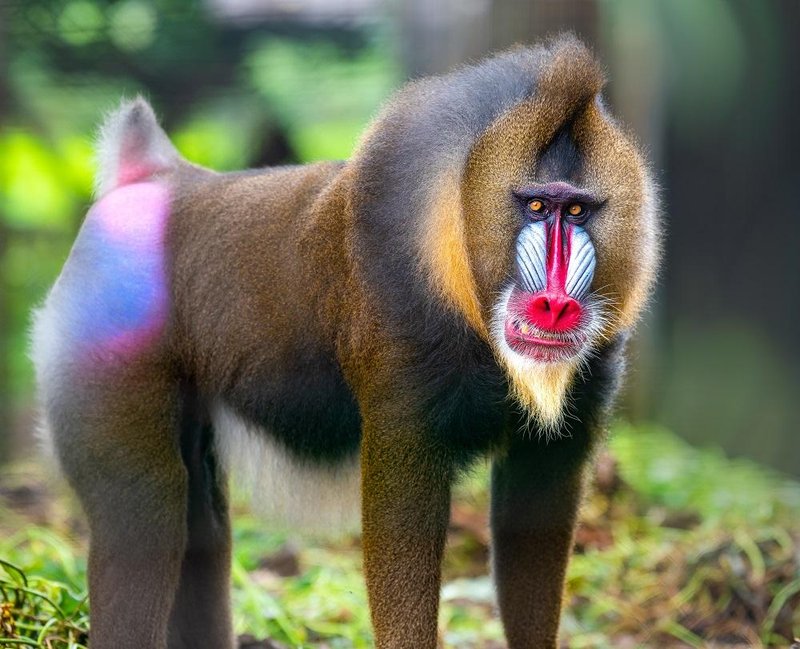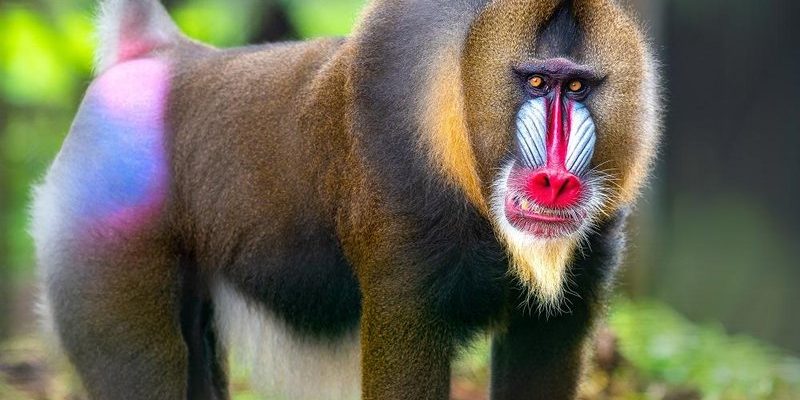
You might think of them as just another primate living in the wild, but there’s so much more beneath the surface. With their vibrant colors and unique social behaviors, mandrills are truly one of a kind. Unfortunately, these characteristics have led to a bunch of myths and misconceptions. In this article, we’ll dive into some of those common myths and clarify what’s true and what’s not about these incredible animals.
Myth 1: Mandrills Are Just Big Monkeys
It’s easy to dismiss mandrills as simply larger versions of your average monkey, but that overlooks their unique features and behaviors. Mandrills are part of the baboon family, which sets them apart from many other primates. They boast larger sizes, with males weighing up to 100 pounds. But it’s not just their size that distinguishes them; it’s their striking appearance.
For example, male mandrills have bright blue and red skin on their faces and posteriors. This colorful display is more than just a pretty face; it plays a crucial role in their social interactions. Only the healthiest mandrills display the brightest colors, signaling their fitness to potential mates. So, in a way, you could say their looks are like a peacock’s feathers—an evolutionary advantage rather than just eye candy.
You might wonder why this distinction matters. Understanding that mandrills aren’t just big monkeys helps us appreciate their complex social structures and unique behaviors. They live in troops of up to 30 individuals, usually led by a dominant male. Each member has a role, and their interactions are filled with communication—often more intricate than you might think.
Myth 2: Mandrills Are Aggressive and Dangerous
There’s a stereotype that surrounds many wild animals, including mandrills, as being inherently aggressive. Sure, mandrills can defend themselves—they are wild animals, after all! But labeling them purely as aggressive is misleading. In their natural habitat, mandrills prioritize social bonds and community life over hostility.
Here’s the thing: Mandrills are primarily shy and tend to avoid human interaction whenever possible. They’d rather forage for fruits and roots in the forest than confront perceived threats. While they can be protective, particularly if a troop member is in danger, their aggression is usually a response to fear or stress rather than a primary trait.
To understand mandrills better, it helps to think of them as introverts. Just like some people prefer to stay in their comfort zones, mandrills often keep their distance from potential threats. By respecting their boundaries, we can foster a better understanding of these spectacular creatures.
Myth 3: Mandrills Live in Trees Only
Another common misconception about mandrills is that they are tree-dwelling animals. While it’s true that they often spend time in the trees—swinging through branches is a fun pastime for them—they also have a strong preference for the forest floor.
Mandrills are terrestrial animals, which means they primarily live on the ground. They forage for food, socialize, and even rest on the forest floor. Their strong limbs help them climb, but they usually return to the ground to eat, mate, and interact with their troop members.
For example, during the day, you might spot them foraging for fruits, leaves, and seeds while occasionally climbing to escape potential predators. This unique blend of behaviors allows mandrills to thrive in their habitats, making them more adaptable than many might think.
Myth 4: Mandrills Are Solitary Creatures
We often associate wild animals with solitary lifestyles, especially when it comes to primates. However, this could not be further from the truth regarding mandrills. These creatures are highly social and live in multi-male, multi-female troops that can include several dozen individuals.
Let me explain: Mandrills have complex social structures with hierarchies and strong bonds among troop members. Interactions within the troop include grooming, playing, and vocalizations. Grooming is essential for maintaining social ties and relieving stress, similar to how a friendly chat can brighten your day.
This social aspect affects their survival, too. Mandrills rely on their troops for protection against predators, sharing the responsibilities of keeping watch and sounding alarms. Their social nature helps them thrive and adapt in the wild.
Myth 5: All Mandrills Are Colorful
When you see images of mandrills, their vibrant colors often steal the show. But here’s the catch: not all mandrills sport those bright hues. In fact, the intense coloration is primarily found in males, especially those dominant in the troop.
Here’s what’s interesting: Young mandrills and females tend to have duller colors, which helps them blend into their surroundings. This camouflage is important for staying safe from predators. It’s only as they reach maturity that males develop their striking features.
This difference illustrates how nature uses color not just for beauty but as a survival strategy. Male mandrills flaunt their colors to attract mates, but younger and female mandrills need to focus on staying safe.
Myth 6: Mandrills Are No Longer Endangered
One common misunderstanding is that mandrills have rebounded from the brink of extinction. Unfortunately, this isn’t the case. While some populations exist, mandrills are still classified as vulnerable due to habitat loss and hunting. Deforestation and human encroachment into their habitats pose significant threats.
Honestly, protecting mandrills is crucial for maintaining the health of their ecosystems. As a species that plays an essential role in dispersing seeds, mandrills help enrich their environments—an aspect that affects many other species.
Conservation efforts are underway, but understanding the plight of these magnificent animals is a step toward ensuring their survival. Supporting organizations that focus on wildlife conservation can help make a significant difference.
As we wrap up our exploration of mandrills, it’s clear that there’s so much more to these creatures than what meets the eye. They are vibrant, social, and vital members of their ecosystems, facing challenges that threaten their existence. By dispelling myths and fostering a better understanding of mandrills, we can appreciate their complexity and beauty.
Next time you think of a mandrill, remember that they’re not just colorful creatures or mere ‘big monkeys.’ They’re sophisticated animals with intricate social lives, strong emotional bonds, and important roles in their habitats. Understanding them helps us protect them—and that’s a journey worth taking.

